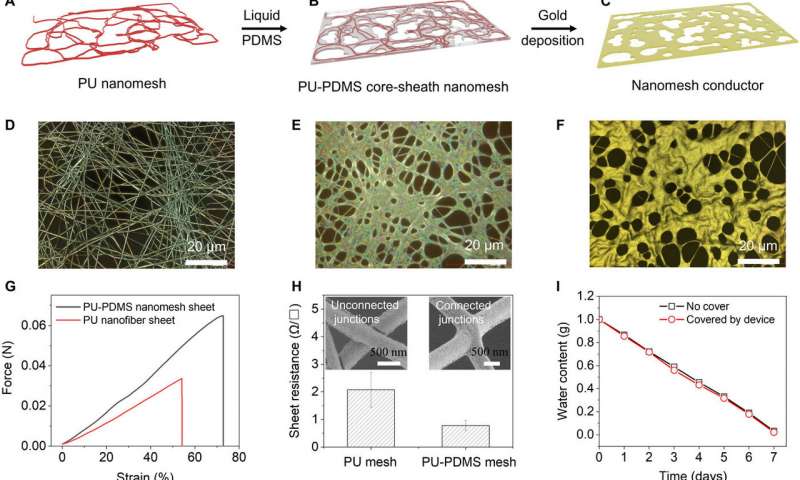HOME
An on-skin durable nanomesh sensor to monitor natural skin motion

Fabrication and characterization of PU-PDMS core-sheath nanomesh conductors. (A to C) Schematic of the fabrication process. (D to F) Corresponding microscopic images of the (D) PU nanofiber sheet, (E) PU-PDMS core-sheath nanomesh, and (F) Au/PU-PDMS nanomesh conductor. (G) Strain-stress curves of the bare PU nanofiber sheet and PU-PDMS nanomeshes. (H) Comparison of the sheet resistances of the bare PU nanomesh conductor and PU-PDMS nanomesh conductor (N = 10); the inset SEM images show the distinctive junction configurations of both devices. (I) Comparison of the water content of two bottles (one is not covered, and the other one is covered by the device). Credit: Science Advances, doi: 10.1126/sciadv.abb7043
Comfortable strain gages can be directly placed on human skin to monitor continuous motion activity with widespread applications in robotics, human motion detection, and personal health care. However, it is challenging to develop an on-skin strain gage to monitor long-term human body motions without disturbing the natural movement of skin. In a new report now on Science Advances, Yan Wang, and a team of scientists in electrical engineering at the University of Tokyo and the Center for Emergent Matter Science in Japan presented an ultrathin and durable nanomesh strain gage. The device allowed continuous motion activity to minimize the mechanical constraints on natural skin motion. They engineered the device using reinforced polyurethane-polydimethylsiloxane (PU-PDMS) nanomeshes for excellent sustainability and durability. The geometry and softness of the device provided minimal mechanical interference for natural skin deformations. During speech tests, for instance, the nanomesh-attached face showed skin strain mapping similar to natural skin without nanomeshes. Wang et al. demonstrated long-term facial mapping to detect real-time, stable body movements with surface-bound nanomesh sensors.
Wearable electronics for on-skin applications are designed to be thin, soft and durable to integrate with human skin for continuous long-term applications. Strain gages have attracted significant interest in bioengineering due to their applications in human-machine interfaces for health diagnostics. Soft and high-precision strain gages can be applied to continuously measure biological organ function. However, they have simpler mechanisms to generate repetitive electrical changes after mechanical deformation, for applications interfacing biological systems. The devices only require high mechanical compliance, flexibility, sensitivity and biocompatibility for optimal function. In this work, Wang et al. developed an ultrathin and durable nanomesh strain gage to detect human movement while minimizing mechanical constraints on natural skin. They used PU-PDMS (polyurethane-polydimethylsiloxane) to engineer the nanomeshes with an ultralight weight of 0.12 mg/cm2 and extraordinary mechanical durability for high-cycle stretching and releasing applications. The team used the setup to successfully map facial skin-strain during speech for up to 3.5 hours with minimal mechanical interference after long-term wear.
During the experiments, the team first electrospun PU (polyurethane) nanofibers to create long, hair-like fibers to form the backbone of the permeable nanomesh sensor. In the next step, they dipped the PU nanofiber sheet into a diluted PDMS (polydimethylsiloxane) solution for the nanofibers to form random bundles encircled by PDMS. Wang et al. subjected the material to mild ultraviolet (UV) ozone exposure to cure the surface and facilitate surface hydrophilicity (water-loving nature) for biocompatibility. They completed the device using gold deposition on both sides and observed the resulting PU-PDMS core sheath using scanning electron microscopy (SEM). The PDMS coating enhanced the interconnectivity between the nanofibers for improved structural integrity of the constructs. The resulting mechanical strength of the free-standing PU-PDMS nanomesh improved greatly with larger stretchability compared to the bare nanofiber sheet and the team also examined its gas permeability.
News Source